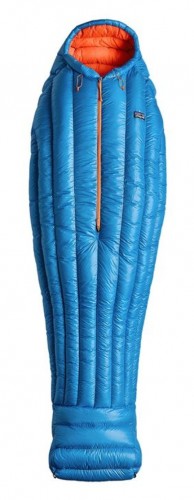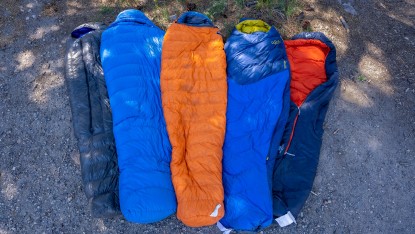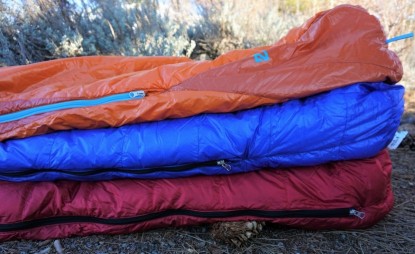Patagonia 850 Down 30 Review
Our Verdict
Our Analysis and Test Results
The Patagonia 850 Down 30 is lighter and more compressible than most models on the market and its half-length zipper is comfortable to hang out and perform morning chores in without having to get out of the bag. It is functional and comfortable while staying clipped in during alpine or big wall ascents, though it fundamentally limits, albeit only slightly, its temperature regulation.
Warmth
The 850 down is rated to 30° F and features "850-fill-power Traceable Down. We tried, but couldn't find the volume of down used per bag in their 30° F model. While we don't know an exact amount, it's fair to say it's a significant amount - Patagonia didn't skimp on fill, which is evident when you see its impressive loft, especially for its temperature rating.
The 850 Down 30 uses a sewn-through construction, which generally speaking, is not as warm as a more classically designed box baffled bag; the sewn points can create cold spots because there isn't any insulation in the spot where the stitching is. That said, despite this construction style, we were impressed by how warm this bag was, finding it comparable to other 30°-35° F bags, like the Mountain Hardwear Hyperlamina Spark 35 or the Sierra Designs Backcountry Bed 700. It wasn't as warm as the Western Mountaineering MegaLite.
The 850 Down 30 maintains enough warmth despite its sewn through construction. It sports a lot of solid loft. This bag uses long vertical baffles through the center of the bag which stabilize down better than continuous horizontal baffles, keeping down where you need it, minimizing it from shifting over time. Some folks like continuous baffles because you can intentionally shift down around to help regulate warmth, but in reality, for a bag of this temperature rating, we think most people are pretty unlikely to do this and will be happier overall with the down staying evenly distributed. Patagonia goes on to make sure that the goose down they used is all 100% traced from farm to factory to help ensure the birds in the supply chain are never force-fed or live-plucked.
Weight
At 1 pound 10 ounces, this bag is certainly lighter-than-average, but not by an extravagant amount. It's similar in weight to the Western Mountaineering MegaLite, but the MegaLite is noticeably roomier and remained slightly warmer overall. Its the same weight as the 25° F REI Co-op Igneo 25 and within 5-6 ounces to some of the lightest bags in our review, like the Sea to Summit Spark III and the Marmot Phase 20. Both the Spark and Phase are warmer and lighter. Overall, this bag is fairly lightweight but not a considerable amount. We found this marginally disappointing considering its sewn-through construction as we certainly get, and support, making some comfort sacrifices for weight savings. However, in this case, you make a small sacrifice for a heavier bag. This is the primary reason the 850 Down 30, while pretty sweet overall, didn't win an award.
Comfort
The lining is made from the same fabric as their incredibly popular Houdini wind shell. This fabric is 100% nylon ripstop; this is more durable than most other models and is very quick to dry, but was only average for its feeling against our skin. Don't get us wrong, we love the Houdini as a wind shell, but it was just so-so of a feeling against our bare skin. It is worth noting though that when it was hot, the Houdini fabric felt less clammy than other more silky feeling nylon materials.
The 850 Down 30's foot box is the best design in our review. It not only provides plenty of room for a backpacker's feet, regardless of being a belly or a back sleeper, but it was also warm. The design performed a superb job of wrapping around the wearer's feet, minimizing the amount of insulation that would get compressed. Our testing team felt that this bag finds a nice balance of thermal efficiency, effectively retaining heat without feeling too tight. The Patagonia 850 Down 30 felt similar to other performance-oriented mummy bags and while it may be slightly snugger in dimension around the leg area, it offers plenty of space to not feel cramped in its torso, as well as the ability to add layers, extending this bag's temperature range if necessary.
Packed Size
This bag packs up smaller-than-average but similar to its overall performance in weight; it didn't quite produce as small of a compressed size as several other models, which again was surprising considering its sewn-through (AKA not baffled) design. The Marmot Phase, Sea to Summit Spark III, and Western Mountaineering MegaLite all compressed smaller but remained warmer. The 850 Down 30 does come with a lightweight stuff sack but it didn't do a great job of minimizing the packed volume of this bag. We found that with an aftermarket compression sack, we could compress this model to nearly half the packed volume versus using the included stuff sack.
Features & Design
This bag has one of the better-designed hoods in our review; it was both comfortable and effective at trapping heat. Its half-length front zipper was an incredible feature while cooking or simply hanging out and enjoying our morning coffee - without having to get out of our bag. Even after some initial skepticism from several of our testers, everyone who used it ended up loving it. While a little specialized, we also appreciated the front zips two-way zipper, making sleeping while tied in and wearing a harness much warmer and more comfortable while alpine or big-wall climbing. Also fitting into the small but nice features, climbers will appreciate the stout clip-in point near the foot of the bag, which helps secure your bag to your portaledge, or help to keep it from blowing away.
Versatility
This bag only offers so-so versatility from a temperature regulation standpoint. The front zipper, while sweet for hanging out on cold mornings cooking and drinking coffee, doesn't effectively facilitate the temperature regulation that we've come to expect from a full-length side zipper. Not only is the half-length less overall distance to ventilate on hot nights (versus this bag's half-length design), but our testers found the front zipper to be a little all-or-nothing when we unzipped it. We noticed ourselves getting cold quickly as the front zipper opened all the way versus the side-zipper, which acted more like a flap. There is plenty of room to add layers to this bag, which you'll likely want to do if sleeping below 35°-40°F.
Best Applications
This bag is best for summertime backpacking and alpine climbing where it will likely be 30° F and above. We found this bag great down to around 35°-40° F, but most folks will want to start to layer up below 40° F. It's weight and packed size, while not the best, are certainly decent enough for the most backpackers on adventures ranging from overnight to thru-hiking. We'd easily take this bag on carry-over style alpine routes. It isn't warm enough (even with layers) for most spring ski tours or early season mountaineering -unless you're willing to punch your ticket to suffer town.
Value
At $400, this bag is in line with other models featuring 800-850 fill-power down, rated to around 30° F. For example, it's the same price as the Sea to Summit Spark III and the Marmot Phase 30 (we reviewed the identical but slightly warmer Phase 20 at $460); however it's heavier than either of those bags. We think the 850 Down 30 by Patagonia brings respectable value, as it is a unique and higher performing bag, at a higher (but not top-tier) price.
Conclusion
The new Patagonia 850 Down 30 is a solid high-performing bag with several sweet features, offering better-than-average weight and packed volume. It wasn't the best overall and we expected it to be slightly lighter and more compressible, especially considering its sewn-through design. It remains a sweet option that will excel at a number of summertime activities and its internal dimensions strike a solid balance of comfort and thermal efficiency. Its half-length front zipper serves a higher purpose than we originally thought and now is at times, hard to live without.
Other Versions
Patagonia also makes the similar in design though baffled and warmer 850 Down Sleeping Bag 19 F (which looks mega sweet!!!) and a half-length elephants foot called the Hybrid sleeping bag.














